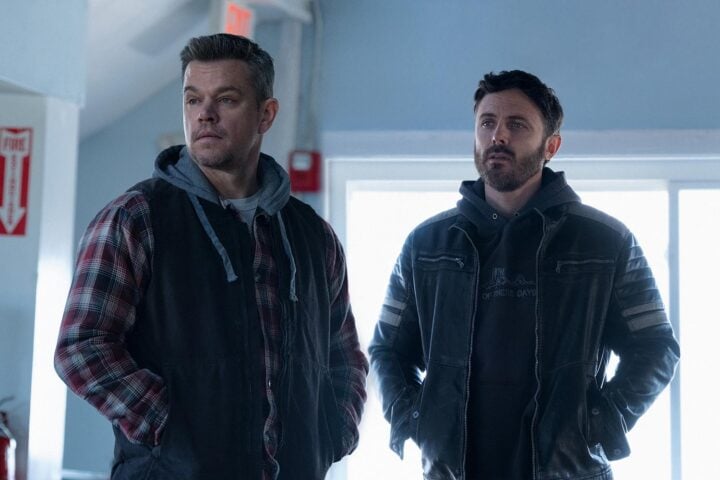Midway through their long journey toward Titan, the crew of the Odyssey 1 spacecraft stumbles onto a troubling thought: What if the sensors that the ship uses to detect malfunctions are themselves malfunctioning? The question becomes more pressing as they witness power cuts and damaged pipes while the ship continues to tell them that everything is a-okay. “Who are you going to believe,” it seems to ask, “me or your lying eyes?”
Mikael Håfström’s Slingshot uses this dilemma as a neat metaphor for the philosophical problem posed to the ship’s three-man crew as their senses are gradually called into question. John (Casey Affleck), Nash (Tomer Capone), and Captain Franks (Laurence Fishburne) are on a trip to Saturn’s largest moon, where they hope to find a rich new source of renewable energy. To reach their destination, they have to pull of an extremely tricky maneuver that involves using Jupiter’s gravitational pull to “slingshot” them the rest of the way. And, to conserve resources along the way, they have to endure a torturous series of hyper-sleep cycles, each of which leaves them a little less certain that the things they see, hear, and remember are really so.
Slingshot’s opening isn’t subtle. John trudges sleepily out of his sleep chamber while a computerized voice (Nikolett Barabas) warns him, in detail, of the physical and mental side effects that its extremely potent sedatives might induce. Nash then repeats this warning to him mere moments later, almost word for word, making sure that the audience can’t possibly miss the cue that John’s perception of the events to follow may not be entirely accurate.
When they discover signs of damage to the ship, the crew is divided on what to do. Nash wants to play it safe and head home while Captain Franks is adamant that they complete their mission, leaving John caught in the middle, unsure of who to trust. As the months wear on and they approach the point of no return—that titular slingshot maneuver—their conflict only intensifies.
Given that it’s largely a thriller about three guys trying not to go insane, Slingshot isn’t very well served by a story structure that has it continually cutting away from the main plot to provide flashbacks of John’s life back on Earth. In and of themselves, the scenes in which he falls for fellow NASA hotshot Zoe (Emily Beecham) are perfectly enjoyable; Affleck and Beecham have good chemistry, and it gives the former a chance to show off a brighter, more human side to a character who spends much of the film stumbling around in a sleepy haze. When Zoe suggests that, in hindsight, getting involved was a really bad idea, John replies with a bashful smile, “Well executed though, wasn’t it?” True astronaut rizz if ever such a thing existed.
But these continued cutaways effectively de-pressurize Slingshot’s main plotline, providing us with regular breathers from the increasingly tense atmosphere aboard Odyssey 1. In space, we see John reawaking from hyper-sleep again and again, getting the same spiel from the vessel’s robotic voice each time. This purposefully repetitive rhythm clearly intends to draw the audience into the man’s increasing sense of disorientation, and the flashbacks disrupt it. Given that they don’t add anything especially vital to the film, it seems a poor trade-off.
In the extraterrestrial portion of the story, Slingshot attempts to convey John’s fraying mental state in unoriginal and largely ineffective ways—all fast-cutting montages of him pacing around looking distressed, whispering disembodied voices, and jump scares. The script, by R. Scott Adams and Nathan Parker, largely hinges on a twist that viewers will almost certainly clock well ahead of time, while many of its other developments rely on three supposedly intelligent men acting in fairly unintelligent ways. A certain amount of that can be attributed to their decaying mental conditions, but some of it simply feels like very clumsy storytelling.
The strongest in the main cast is Fishburne, who gives a typically magnetic performance. He’s excellent casting for a film that wants to toy with our perception of his character: One moment he seems like a figure of perfect, level-headed authority, the next a towering menace. In between, he’s your most charming uncle—sipping homemade moonshine and singing along to the Animals’ famous, fitting hit: “Oh Lord, please don’t let me be misunderstood.”
Right at the very end, Håfström’s film does find an excellent way to dramatize that central, horrifying question about how we navigate a world that we can only perceive through our own extremely fallible faculties. Ultimately, though, Slingshot proves to be not quite as skilled as the Odyssey 1’s crew, as it sets course for a really thought-provoking concept but can’t make the landing and ends up floating awkwardly around in its orbit instead.
Since 2001, we've brought you uncompromising, candid takes on the world of film, music, television, video games, theater, and more. Independently owned and operated publications like Slant have been hit hard in recent years, but we’re committed to keeping our content free and accessible—meaning no paywalls or fees.
If you like what we do, please consider subscribing to our Patreon or making a donation.






